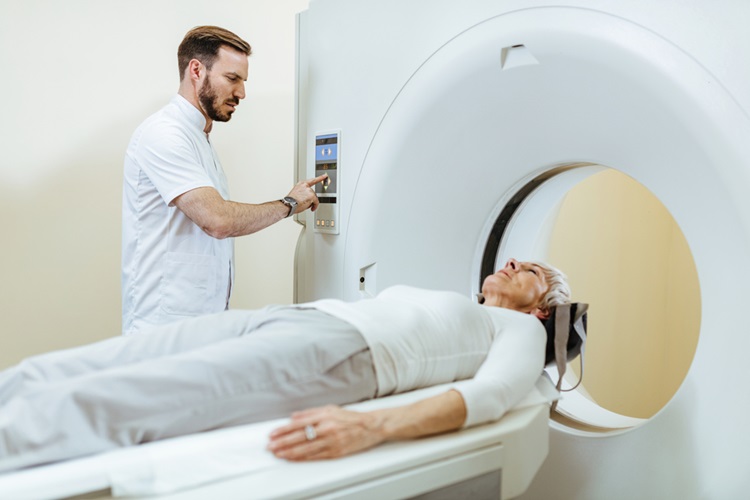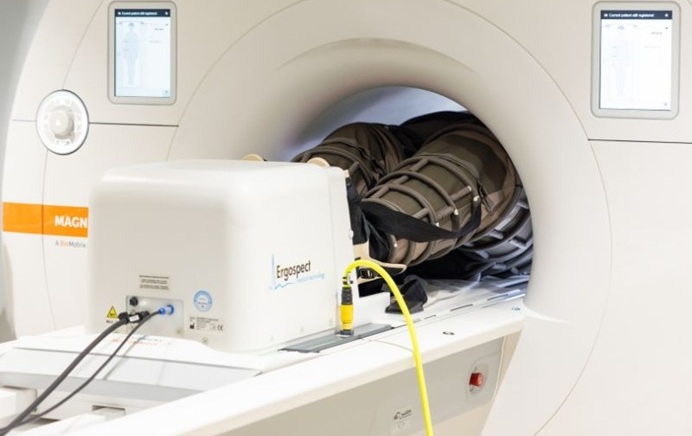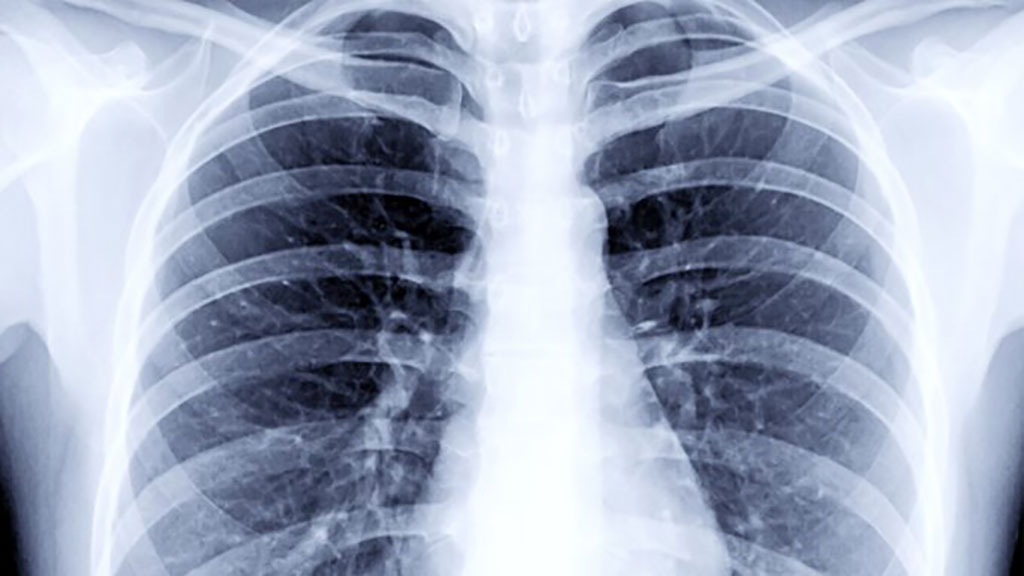Nanoparticle Carries Imaging and Medicinal Components
|
By MedImaging International staff writers Posted on 11 Sep 2008 |
Ultra-miniature bialy-shaped particles--called nanobialys because they resemble tiny versions of the flat, onion-topped rolls popular in New York City--could soon be carrying medicinal compounds through patients' bloodstreams to fight tumors or atherosclerotic plaques.
The nanobialys are an important addition to the range of diagnostic and disease-fighting nanoparticles developed by researchers from the Consortium for Translational Research in Advanced Imaging and Nanomedicine (C-TRAIN) at Washington University School of Medicine in St. Louis (MO, USA). C-TRAIN's "smart” nanoparticles can deliver drugs and imaging agents directly to the site of tumors and plaques.
The nanobialys were not engineered for their appealing shape--that is a natural result of the manufacturing process. The particles answered a need for an alternative to the investigators gadolinium-containing nanoparticles, which were created for their high visibility in magnetic resonance imaging (MRI) scans.
Gadolinium is a common contrast agent for MRI scans, but recent studies have shown that it can be harmful to some patients with severe kidney disease. "The nanobialys contain manganese instead of gadolinium,” said first author Dipanjan Pan, Ph.D., research instructor in medicine in the cardiovascular division. "Manganese is an element found naturally in the body. In addition, the manganese in the nanobialys is tied up so it stays with the particles, making them very safe.”
The majority of a nanobialy is a synthetic polymer that can accept a host of medical, imaging, or targeting components. In the July 2008 issue of the Journal of the American Chemical Society (JACS), the researchers reported that targeted manganese-carrying nanobialys promptly attached themselves to fibrin molecules, which are found in atherosclerotic plaques and blood clots. Laboratory-made clots then glowed brightly in MRI scans. The researchers also demonstrated that the nanobialys could carry both water-soluble and insoluble drugs.
Dr. Pan, who is a research instructor in medicine, played a leading role in the creation of nanobialys and chose the particles' name. "When we looked at the particles with an electron microscope, we saw they are round and flat, with a dimple in the center, like red blood cells, but also a little irregular, like bagels,” he commented. "I came across the word bialy, which is a Polish roll like a bagel without a hole that can be made with different toppings. So I called the particles nanobialys.”
Nanoparticles can be a more effective way to administer medications and imaging contrast agents because they are targeted, packaged units--drugs and imaging agents remain on the nanoparticles, which can be made to concentrate at a specific site in the body. In animal studies, the research group has shown that their original, spherical nanoparticles can carry therapeutic compounds to tumors and atherosclerotic plaques. These nanoparticles also can hold thousands of molecules of gadolinium, which allows the researchers to use conventional MRI scanning equipment to see where the nanoparticles congregate. The scans can then detect the size of lesions as well as the effect of drugs delivered by the nanoparticles.
However, gadolinium has recently been linked to nephrogenic systemic fibrosis (NSF). First described in 2000, NSF is an unusual progressive, incurable disease seen in approximately 3% of patients with severe kidney disease who have had MRI scans using gadolinium. In NSF, collagen accumulates in tissues causing skin hardening and thickening, joint stiffening that can lead to physical disability, and disorders of the liver, lungs, heart, and the muscles.
"Even though it seems that gadolinium affects only those with severe renal failure, physicians have decided not to use gadolinium even in those with moderate renal failure,” stated Gregory M. Lanza, M.D., Ph.D., an associate professor of medicine and biomedical engineering at Washington University. "A lot of patients with diabetes or hypertension develop renal failure, so that decision potentially affects many people. Our goal has always been that our nanoparticle technology should be able to help everyone. And with a growing number of people having diabetes and related cardiovascular problems, we knew we needed to find a substitute for gadolinium-based particles--nanobialys are our first step in that direction.”
The researchers will continue to modify the nanobialys for a variety of medicinal applications and work to develop other types of nanoparticles so that they can supply a wide range of medical needs. "We're not sitting in the lab generating nanoparticles and then looking for what they could be used for,” Dr. Lanza said. "We see a medical problem, and ask what kind of particle might overcome it and then try to create it.”
Related Links:
Consortium for Translational Research in Advanced Imaging and Nanomedicine
The nanobialys are an important addition to the range of diagnostic and disease-fighting nanoparticles developed by researchers from the Consortium for Translational Research in Advanced Imaging and Nanomedicine (C-TRAIN) at Washington University School of Medicine in St. Louis (MO, USA). C-TRAIN's "smart” nanoparticles can deliver drugs and imaging agents directly to the site of tumors and plaques.
The nanobialys were not engineered for their appealing shape--that is a natural result of the manufacturing process. The particles answered a need for an alternative to the investigators gadolinium-containing nanoparticles, which were created for their high visibility in magnetic resonance imaging (MRI) scans.
Gadolinium is a common contrast agent for MRI scans, but recent studies have shown that it can be harmful to some patients with severe kidney disease. "The nanobialys contain manganese instead of gadolinium,” said first author Dipanjan Pan, Ph.D., research instructor in medicine in the cardiovascular division. "Manganese is an element found naturally in the body. In addition, the manganese in the nanobialys is tied up so it stays with the particles, making them very safe.”
The majority of a nanobialy is a synthetic polymer that can accept a host of medical, imaging, or targeting components. In the July 2008 issue of the Journal of the American Chemical Society (JACS), the researchers reported that targeted manganese-carrying nanobialys promptly attached themselves to fibrin molecules, which are found in atherosclerotic plaques and blood clots. Laboratory-made clots then glowed brightly in MRI scans. The researchers also demonstrated that the nanobialys could carry both water-soluble and insoluble drugs.
Dr. Pan, who is a research instructor in medicine, played a leading role in the creation of nanobialys and chose the particles' name. "When we looked at the particles with an electron microscope, we saw they are round and flat, with a dimple in the center, like red blood cells, but also a little irregular, like bagels,” he commented. "I came across the word bialy, which is a Polish roll like a bagel without a hole that can be made with different toppings. So I called the particles nanobialys.”
Nanoparticles can be a more effective way to administer medications and imaging contrast agents because they are targeted, packaged units--drugs and imaging agents remain on the nanoparticles, which can be made to concentrate at a specific site in the body. In animal studies, the research group has shown that their original, spherical nanoparticles can carry therapeutic compounds to tumors and atherosclerotic plaques. These nanoparticles also can hold thousands of molecules of gadolinium, which allows the researchers to use conventional MRI scanning equipment to see where the nanoparticles congregate. The scans can then detect the size of lesions as well as the effect of drugs delivered by the nanoparticles.
However, gadolinium has recently been linked to nephrogenic systemic fibrosis (NSF). First described in 2000, NSF is an unusual progressive, incurable disease seen in approximately 3% of patients with severe kidney disease who have had MRI scans using gadolinium. In NSF, collagen accumulates in tissues causing skin hardening and thickening, joint stiffening that can lead to physical disability, and disorders of the liver, lungs, heart, and the muscles.
"Even though it seems that gadolinium affects only those with severe renal failure, physicians have decided not to use gadolinium even in those with moderate renal failure,” stated Gregory M. Lanza, M.D., Ph.D., an associate professor of medicine and biomedical engineering at Washington University. "A lot of patients with diabetes or hypertension develop renal failure, so that decision potentially affects many people. Our goal has always been that our nanoparticle technology should be able to help everyone. And with a growing number of people having diabetes and related cardiovascular problems, we knew we needed to find a substitute for gadolinium-based particles--nanobialys are our first step in that direction.”
The researchers will continue to modify the nanobialys for a variety of medicinal applications and work to develop other types of nanoparticles so that they can supply a wide range of medical needs. "We're not sitting in the lab generating nanoparticles and then looking for what they could be used for,” Dr. Lanza said. "We see a medical problem, and ask what kind of particle might overcome it and then try to create it.”
Related Links:
Consortium for Translational Research in Advanced Imaging and Nanomedicine
Latest MRI News
- Novel Imaging Approach to Improve Treatment for Spinal Cord Injuries
- AI-Assisted Model Enhances MRI Heart Scans
- AI Model Outperforms Doctors at Identifying Patients Most At-Risk of Cardiac Arrest
- New MRI Technique Reveals Hidden Heart Issues
- Shorter MRI Exam Effectively Detects Cancer in Dense Breasts
- MRI to Replace Painful Spinal Tap for Faster MS Diagnosis
- MRI Scans Can Identify Cardiovascular Disease Ten Years in Advance
- Simple Brain Scan Diagnoses Parkinson's Disease Years Before It Becomes Untreatable
- Cutting-Edge MRI Technology to Revolutionize Diagnosis of Common Heart Problem
- New MRI Technique Reveals True Heart Age to Prevent Attacks and Strokes
- AI Tool Predicts Relapse of Pediatric Brain Cancer from Brain MRI Scans
- AI Tool Tracks Effectiveness of Multiple Sclerosis Treatments Using Brain MRI Scans
- Ultra-Powerful MRI Scans Enable Life-Changing Surgery in Treatment-Resistant Epileptic Patients
- AI-Powered MRI Technology Improves Parkinson’s Diagnoses
- Biparametric MRI Combined with AI Enhances Detection of Clinically Significant Prostate Cancer
- First-Of-Its-Kind AI-Driven Brain Imaging Platform to Better Guide Stroke Treatment Options
Channels
Radiography
view channel
X-Ray Breakthrough Captures Three Image-Contrast Types in Single Shot
Detecting early-stage cancer or subtle changes deep inside tissues has long challenged conventional X-ray systems, which rely only on how structures absorb radiation. This limitation keeps many microstructural... Read more
AI Generates Future Knee X-Rays to Predict Osteoarthritis Progression Risk
Osteoarthritis, a degenerative joint disease affecting over 500 million people worldwide, is the leading cause of disability among older adults. Current diagnostic tools allow doctors to assess damage... Read moreMRI
view channel
Novel Imaging Approach to Improve Treatment for Spinal Cord Injuries
Vascular dysfunction in the spinal cord contributes to multiple neurological conditions, including traumatic injuries and degenerative cervical myelopathy, where reduced blood flow can lead to progressive... Read more
AI-Assisted Model Enhances MRI Heart Scans
A cardiac MRI can reveal critical information about the heart’s function and any abnormalities, but traditional scans take 30 to 90 minutes and often suffer from poor image quality due to patient movement.... Read more
AI Model Outperforms Doctors at Identifying Patients Most At-Risk of Cardiac Arrest
Hypertrophic cardiomyopathy is one of the most common inherited heart conditions and a leading cause of sudden cardiac death in young individuals and athletes. While many patients live normal lives, some... Read moreUltrasound
view channel
Wearable Ultrasound Imaging System to Enable Real-Time Disease Monitoring
Chronic conditions such as hypertension and heart failure require close monitoring, yet today’s ultrasound imaging is largely confined to hospitals and short, episodic scans. This reactive model limits... Read more
Ultrasound Technique Visualizes Deep Blood Vessels in 3D Without Contrast Agents
Producing clear 3D images of deep blood vessels has long been difficult without relying on contrast agents, CT scans, or MRI. Standard ultrasound typically provides only 2D cross-sections, limiting clinicians’... Read moreNuclear Medicine
view channel
PET Imaging of Inflammation Predicts Recovery and Guides Therapy After Heart Attack
Acute myocardial infarction can trigger lasting heart damage, yet clinicians still lack reliable tools to identify which patients will regain function and which may develop heart failure.... Read more
Radiotheranostic Approach Detects, Kills and Reprograms Aggressive Cancers
Aggressive cancers such as osteosarcoma and glioblastoma often resist standard therapies, thrive in hostile tumor environments, and recur despite surgery, radiation, or chemotherapy. These tumors also... Read more
New Imaging Solution Improves Survival for Patients with Recurring Prostate Cancer
Detecting recurrent prostate cancer remains one of the most difficult challenges in oncology, as standard imaging methods such as bone scans and CT scans often fail to accurately locate small or early-stage tumors.... Read moreGeneral/Advanced Imaging
view channel
3D Scanning Approach Enables Ultra-Precise Brain Surgery
Precise navigation is critical in neurosurgery, yet even small alignment errors can affect outcomes when operating deep within the brain. A new 3D surface-scanning approach now provides a radiation-free... Read more
AI Tool Improves Medical Imaging Process by 90%
Accurately labeling different regions within medical scans, a process known as medical image segmentation, is critical for diagnosis, surgery planning, and research. Traditionally, this has been a manual... Read more
New Ultrasmall, Light-Sensitive Nanoparticles Could Serve as Contrast Agents
Medical imaging technologies face ongoing challenges in capturing accurate, detailed views of internal processes, especially in conditions like cancer, where tracking disease development and treatment... Read more
AI Algorithm Accurately Predicts Pancreatic Cancer Metastasis Using Routine CT Images
In pancreatic cancer, detecting whether the disease has spread to other organs is critical for determining whether surgery is appropriate. If metastasis is present, surgery is not recommended, yet current... Read moreImaging IT
view channel
New Google Cloud Medical Imaging Suite Makes Imaging Healthcare Data More Accessible
Medical imaging is a critical tool used to diagnose patients, and there are billions of medical images scanned globally each year. Imaging data accounts for about 90% of all healthcare data1 and, until... Read more
Global AI in Medical Diagnostics Market to Be Driven by Demand for Image Recognition in Radiology
The global artificial intelligence (AI) in medical diagnostics market is expanding with early disease detection being one of its key applications and image recognition becoming a compelling consumer proposition... Read moreIndustry News
view channel
GE HealthCare and NVIDIA Collaboration to Reimagine Diagnostic Imaging
GE HealthCare (Chicago, IL, USA) has entered into a collaboration with NVIDIA (Santa Clara, CA, USA), expanding the existing relationship between the two companies to focus on pioneering innovation in... Read more
Patient-Specific 3D-Printed Phantoms Transform CT Imaging
New research has highlighted how anatomically precise, patient-specific 3D-printed phantoms are proving to be scalable, cost-effective, and efficient tools in the development of new CT scan algorithms... Read more
Siemens and Sectra Collaborate on Enhancing Radiology Workflows
Siemens Healthineers (Forchheim, Germany) and Sectra (Linköping, Sweden) have entered into a collaboration aimed at enhancing radiologists' diagnostic capabilities and, in turn, improving patient care... Read more



















